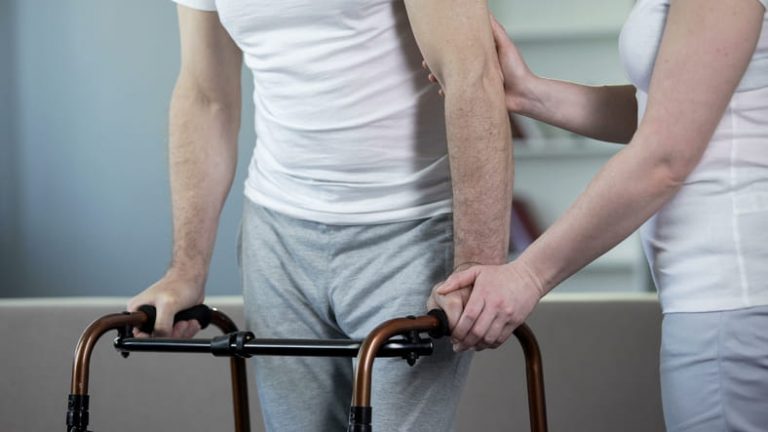What Is Short-Term Rehabilitation?

So, what exactly is short-term rehabilitation? Short-term rehabilitation is a type of treatment designed to promote healing after a significant health event or injury. Short-term rehabilitation services often prioritize care for older adults, offering customized treatment plans for a finite period of time that improve or restore a person’s health and well-being.
Let’s look at some reasons your loved one may need short-term rehabilitation, the benefits of short-term rehabilitation, what treatments it involves, and how to get your loved one the care and support they need to promote their recovery.
What Is Short-Term Rehabilitation?
Short-term rehabilitation is a treatment program that provides therapy services tailored to each individual’s needs. The ultimate goal is to restore functions and health within a short timeframe. Short-term rehabilitation benefits those who can regain their functionality and return to their home environment after treatment.
Long-term rehabilitation services are designed for individuals with chronic health conditions or disabilities who require indefinite care. Short-term rehabilitation differs from long-term rehabilitation because their objective is for patients to heal and return to their home environment, while long-term care has the following objectives:
- Maintain quality of life
- Manage health
- Provide ongoing support
Rehabilitation Services Offered
Therapy services offered by short-term rehabilitation programs include occupational therapy, physical therapy, and speech therapy. Short-term rehabilitation provides specialized care for patients by assessing their needs, identifying their treatment goals, and developing custom treatment plans designed to help them achieve those goals. Some patients may need all therapy services offered, while others may only need one or two.
Occupational Therapy
Occupational therapy focuses on daily living tasks and fine motor skills. Occupational therapists use exercises to strengthen the muscles in the hands and improve hand-eye coordination. Occupational therapy can help patients relearn how to perform daily living tasks, such as brushing their teeth and tying their shoelaces.
Physical Therapy
Physical therapy enhances gross motor skills, improves balance, and facilitates pain management.
Physical therapists use exercises to help patients improve the following:
- Balance
- Coordination
- Mobility
- Strength
Speech Therapy
Speech therapists use exercises to help patients improve or regain their ability to swallow and speak. For some, the objective of speech therapy may be to improve communication. For others, the goal may be to eat and drink safely.
The Recovery Process
The recovery process in short-term rehabilitation includes the following:
- Evaluation: Medical professionals evaluate patients, identify their health needs, establish treatment goals, and determine the necessary treatments to achieve those goals.
- Therapy: Patients begin treatment with occupational, physical, and speech therapists.
- Ongoing assessment: The medical team monitors patients to determine their progress during treatment.
- Treatment modification: The therapists may adjust a patient’s treatment plan based on their progress. A patient having difficulty or pain while completing exercises may need their treatment simplified or altered. A patient who is improving rapidly may need more challenging exercises to ensure continued progress.
Creating a Treatment Plan
Each medical professional must assess each patient to determine their needs and establish recovery goals. This may involve asking the patient questions, reviewing their medical records, and having them perform various tasks to identify their strengths and weaknesses.
Once each therapist has a clear understanding of the individual’s health issues, they use their expertise to develop a treatment plan to help them regain functionality. This may involve teaching them to use assistive devices, helping them rebuild muscle strength, and assisting them in improving their coordination and balance.
How Care Teams Guide Patients
Care teams guide patients by completing the following:
- Evaluating patients.
- Identifying patient treatment goals.
- Developing personalized treatment plans.
- Overseeing therapeutic services.
- Monitoring patient progress.
- Adjusting goals and treatments as needed.
Care teams communicate with patients and their families, relaying information about the patient’s progress, any needs they may have when returning to their home environment, and how to ensure their continued well-being after discharge.
Common Reasons for Short-Term Rehabilitation
Short-term rehabilitation offers post-hospitalization and post-treatment care for individuals recovering from illnesses, injuries, and surgical procedures.
Illness
Some severe health issues, including diabetes and stroke, are more likely to affect older adults.
Individuals with diabetes can benefit from physical therapy by improving their mobility and blood sugar levels through regular physical activity.
Speech therapy can help individuals who have suffered a stroke regain their ability to speak and swallow. Occupational therapy can help them regain hand-eye coordination. Physical therapy can also help them regain muscle strength, balance, and coordination.
Injuries
Common causes of injuries for older adults include car accidents and falls.
Common injuries from car accidents include the following:
- Broken bones
- Lacerations
- Soft tissue damage
- Traumatic brain injuries (TBIs)
Each year, 25% of older adults suffer a fall. Falls can cause multiple types of injuries, including broken bones, TBIs, and spinal cord injuries.
Surgery
Individuals may benefit from short-term rehabilitation after surgery, including joint replacement surgery. These individuals may initially need assistive devices to complete some tasks or may require them permanently if a full recovery is not expected.
Short-Term Rehabilitation in Utah
Short-term rehabilitation facilities in Utah feature highly trained teams of medical professionals who possess the necessary experience and credentials to assess patients and develop and implement effective treatment plans.
Individuals requiring short-term rehabilitation may be eligible to use Medicare or private insurance to cover the cost. Monument Health Group offers short-term rehabilitation in 11 locations throughout Utah, enabling older adults to receive expert care and support while recovering near their homes and families.
Short-term rehabilitation staff provide expert care by customizing personalized treatment plans tailored to their recovery goals. Short-term rehabilitation staff also deliver essential care by providing 24/7 medical care and opportunities for social engagement with other patients and visitors, which helps boost morale during their recovery.
Benefits of Short-Term Rehabilitation
The benefits of short-term rehabilitation include the following:
- Confidence
- Faster recovery times
- Improved mobility
- Strength
Short-term rehabilitation services include social and emotional support, ensuring patients have social opportunities to prevent or reduce feelings of loneliness, which can cause depression and slow their recovery.
Secure Short-Term Rehabilitation Now
Short-term rehabilitation provides the therapy services individuals need to recover from illness, injury, or surgery. Exceptional short-term rehabilitation service providers, such as Monument Health Group, provide expert personalized care for each individual, enabling them to recover and regain their independence as soon as possible.

